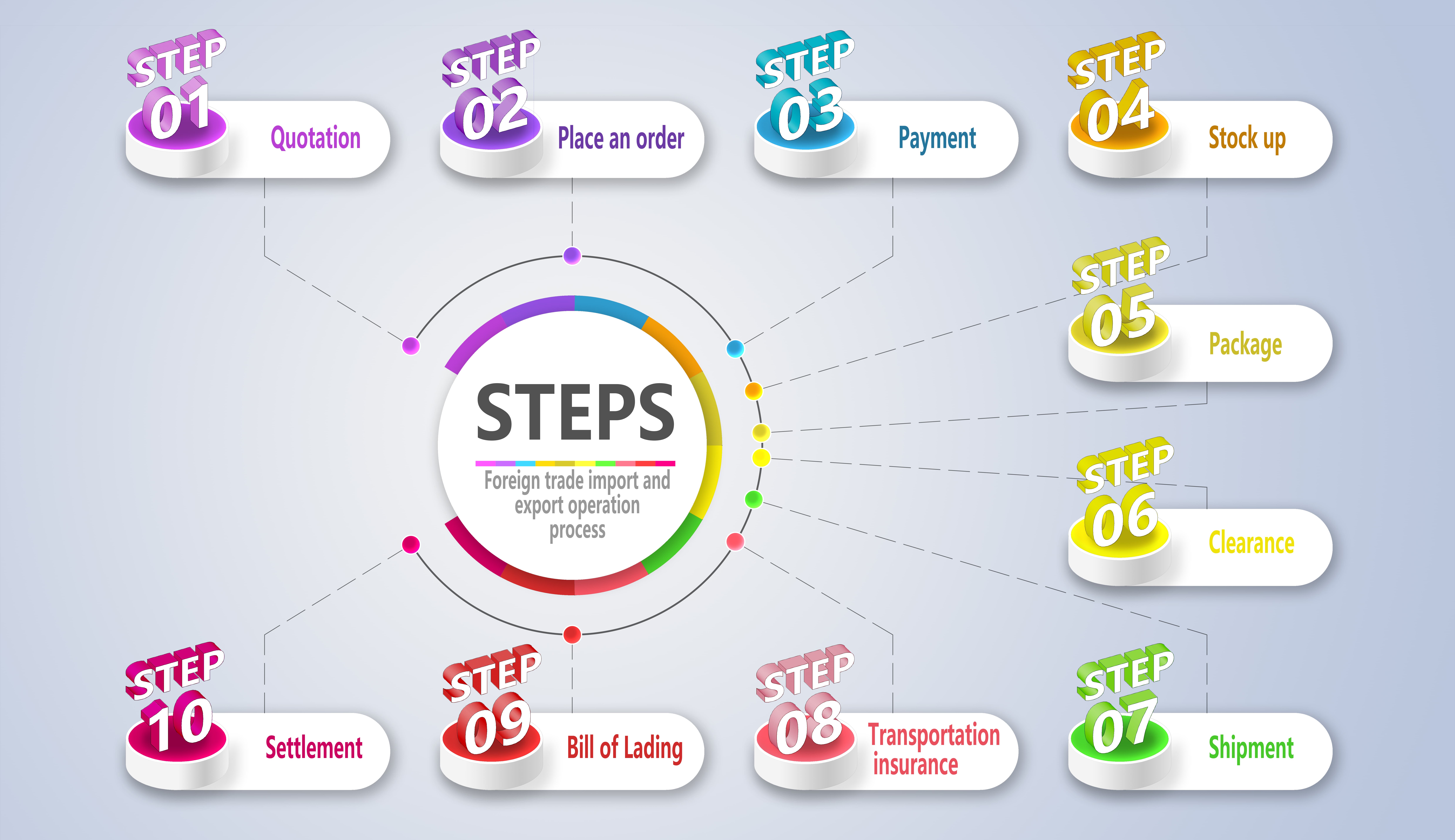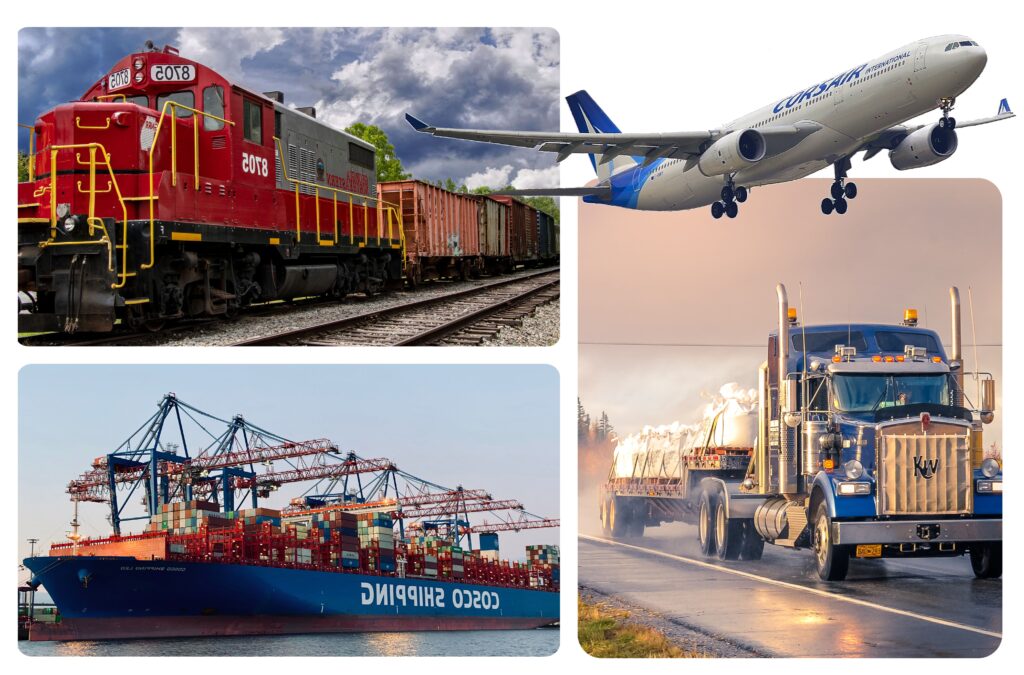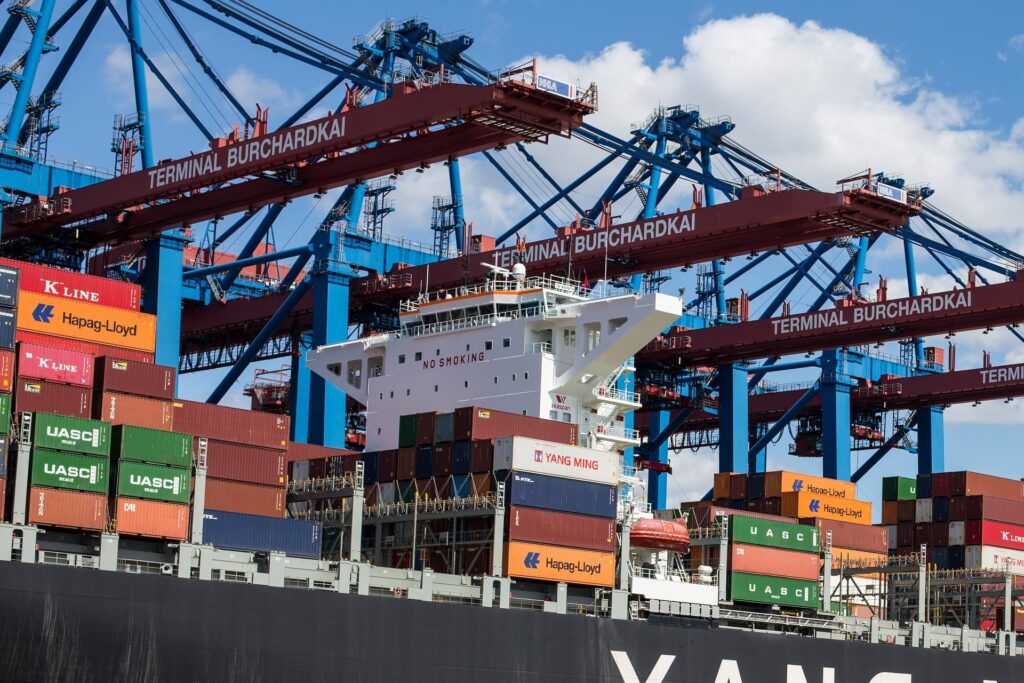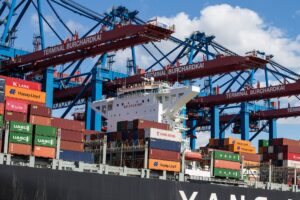In the process of globalization, trade exchanges between countries are becoming more frequent. How to effectively control logistics costs will be an indispensable part of international trade.
1. The Specific Operation Process of Foreign Trade Import and Export
With the continuous deepening of globalization , import and export trade activities are becoming more and more popular. Then, you may be wondering, what is the specific operation process of foreign trade import and export, the following picture will give you a clear understanding.

2. Modes of Transportation in International Trade
The commonly used modes of transportation in international trade include shipping, railway, air transport, truck transport, and multimodal transport.
(1). Shipping
It refers to the act of the carrier, in accordance with the agreement of the sea cargo transportation contract, using the sea ship as the means of transportation and collecting the freight as remuneration to transport the cargo consigned by the shipper through the sea from the port of one country to the port of another country.
Advantages: large transportation volume, low cost, and easy access to waterways.
Disadvantages: slow speed, high risk of sailing, difficult to determine sailing date
It is suitable for goods with low added value, relatively low timeliness requirements, and relatively heavy weight.
(2). International railway transport
Refers to the “land bridge” transportation method that adopts vehicle transportation, combined vehicle transportation, less-than-carload transportation, two or three station unloading, container train transportation, general container transportation, and railways, using flat cars, gondola cars, box cars, tank cars, heat preservation and The application of railway vehicles such as refrigerated trucks and special vehicles in logistics.
Advantages: strong transportation capacity, not affected by weather, can ensure frequent and continuous operation, safety, and punctuality
Disadvantages: investment and maintenance costs are relatively high; there are differences in gauges.
(3). Air transport
Refers to a mode of transportation that uses airplanes as a means of transportation for cargo transportation under the condition that there are aviation routes and airports.
Advantages: fast speed (air freight is the fastest of all modes of transportation), high safety
Disadvantages: expensive (like its speed, air freight is also the most expensive in international trade), and flight is restricted by climatic conditions.
Suitable for light weight and high value-added goods.
(4). Truck transport
It is the abbreviation of truck air transportation, which means truck transportation service like air speed. The use of high speed throughout the journey, without stopping in the middle, without overloading, can greatly improve the transportation timeliness.
Advantages: subject to space restrictions and relatively loose receiving restrictions (for some dangerous goods, such as built-in batteries, supporting batteries and liquids)
Disadvantages: Affected by the weather, the price is relatively high
(5). Multimodal transport
The transportation process in which two or more vehicles are connected and transferred together is collectively referred to as compound transportation.
Advantages: Simplify shipping, settlement and claims procedures, saving manpower, material resources and related costs. Improve the quality of freight, save various expenses, improve the level of transportation management, and complete the rationalization of transportation.
Weaknesses: Simplify shipping, settlement and claims procedures, saving manpower, material resources and related costs. Improve the quality of freight, save various expenses, improve the level of transportation management, and complete the rationalization of transportation.
| Mode of Transport | Advantages | Disadvantages |
| Rail transport | The price is moderate, the volume is large, and the speed is faster than the shipping | Difficulty in tracking information, transfer and marshalling may cause delays |
| Car transport | Fast delivery, flexible, moderate price | High risk of accident |
| Maritime transport | Low price, unlimited transportation | Long sailing period, greatly affected by weather and port conditions |
| Air transport | Obvious advantages in transportation time in remote areas | High cost, limited size and quantity |
| Multimodal transport | Shorten transportation time, reduce transportation costs, and simplify shipping, settlement and claims procedures | Carriers have high requirements on capabilities, and the risk of cargo is high |
| International express | Fast, door-to-door service, wide geographical coverage | The size and weight are limited, and the price is expensive |

3. The Expenses Arising From the Import and Export of Goods
In addition, the expenses arising from the import and export of goods that we are most concerned about are composed of the following main parts:
(1). Domestic trailer fee
(2). Export declaration fee
(3). Port construction fee
(4). Port operation fee, document fee and port miscellaneous fee
(5). Sea freight (or air freight), taking sea freight as an example;
(6). Freight insurance premium;
(7). Customs clearance duty at destination
(8). Miscellaneous charges, cabin rent, container rent, etc. at the port of destination
4. New Changes in Shipping
While the global aviation industry is in trouble because of COVID-19, the shipping industry is very busy. Due to the impact of the epidemic on the ecology of the shipping industry, the sharp increase in replenishment demand in Europe and the United States, and the shortage of containers in export hubs, the global container freight rate soared to a record high. With Christmas approaching, the demand for Christmas goods in Europe and the United States will surge, which will tighten the shipping space. It is expected that the freight for exports from China to Europe and the United States will rise again before the end of the year. The problem of global container shortage is serious. Bloomberg estimates that the global container gap has exceeded 500000 20 foot containers, resulting in soaring freight rates. In the case of a large number of lack of counters, the quotation for the trans Pacific route with a freight of about $2000 in the past has been as high as $13000 in mid February this year.
Shipping experts said that in the context of Western retailers and manufacturers eager to replenish the inventory exhausted during the epidemic, many links of the supply chain were interrupted, resulting in delays in ports and inland distribution networks and rising shipping prices. Supply chain experts said that the rise in sea freight prices has left many shippers, especially those with relatively low value of goods, with a choice: either pay a high price and try to pass on the cost to customers, or withdraw from the overseas market.
Today, how to save freight efficiently has become an urgent problem to be solved!
5. How to Make Efficient Use of Containers to Save Freight Costs
Next, taking shipping as an example, we will talk about how to make efficient use of containers to save freight costs.
(1). Optimize Transportation Routes
Route optimization is another way to reduce freight. Analyze the routes used by each carrier to deliver goods and select the best route for goods transportation.
(2). Choose a More Appropriate Mode of Transportation
It is usually cheaper to transport goods by sea than by air. If necessary, you can consider even multiple ways of mixing. The combination of air, sea and land transportation may help you reduce costs.
Take time to thoroughly study the advantages and disadvantages of each mode of transportation, and then make a decision.
(3). Shop Around to Understand and Compare the Market Price of Containers Through Multiple Channels
A lot of data can help you understand the market trend. Obtain cost estimates from several different companies and compare them. Freight cost benchmark in the market is also an effective method followed by many shippers.
(4). Focus on Packaging, Product Design and Cartons
Minimize the space occupied by each product, find transportation materials that meet your needs, and get more benefits during transportation.
Contacting your carrier in advance and determining the best packaging quantity of your products can save supply costs and make more space for more products.
Waste of space can be eliminated by using cartons, boxes, bags or other packaging materials of the appropriate size or customized according to the size of the container to be used for shipment.
(5). Integrate Your Goods
Reduce the use of less than carload (LCL) and 20 foot containers because LCL or LCL shipments involve multiple costs compared with FCL.
Integrate LCL cargo into 40 foot and high cubic containers.
Merging smaller goods into larger goods can help reduce the cost of capital by integrating your goods and others’ goods into the same country.
In order to save shipping costs, your best strategy is to load as many goods into containers as possible. The more you pack in a container, the less you pay per unit. Better coordinate with suppliers or customers, arrange production plans for similar products, and try to fill containers as much as possible to save unit freight on a regular basis.

(6). Arrange the Delivery Plan and Do Not Pay More for Urgent Orders
Reduce emergency orders through careful planning and schedule management, because emergency orders will incur high additional costs. Avoid unnecessary costs due to demurrage or detention in Pol or pod.
(7). Pay Attention to Additional Costs
Operators usually provide other services, such as loading and unloading goods, wrapping some wooden racks or making additional stops. Such services are usually not included in your cost estimate. Therefore, customers are sometimes surprised when they receive invoices. For this reason, make sure you ask the company for any additional costs you can expect.
Some of the most common unforeseen costs come from not understanding and not applying surcharges. In order to learn to identify these services that may require additional charges, please understand the Incoterms involved, the shipping terms (CY-CY, cfs-cy, etc.) and the costs associated with them, because these terms can help you determine who paid the shipping costs and their responsibilities.
(8). Review Your Quotation
Ensure that the quotation received from the carrier is correct . In some cases, the carrier may miss some freight surcharges and pay you at a later stage. These may also be expensive for you because you or your customers may not agree to pay additional fees after the end of the business.
(9). Establish Long-term Relationship With Medium-sized Freight Forwarders
Establish a long-term relationship with medium-sized international freight forwarders who transport thousands of containers for their customers every year. Freight forwarders can enjoy discounts on sea freight and railway and truck freight, and the transportation expenses you pay will be much cheaper. Formulate annual commitments and provide quantity assurance and import and export opportunities. Good communication with freight forwarders is rewarding. The more loyal you are to your operator, when the capacity is tightened, your carrier will be more likely to focus on the freight of people who have worked with them for longer and have a stable or reliable freight volume.
(10). Understanding Tariffs
In international transportation, it is very important to obtain tariff information to save money. Strive to reduce costs and make your enterprise more profitable as a whole.
6. Summary
Effective control of logistics cost is an essential part of foreign trade cost control. Due to the long freight distance, long freight cycle and different policies of import and export sides, international logistics has a certain complexity. At the same time, the logistics situation of each country and region is slightly different. This article only briefly describes some knowledge about logistics, hoping to be helpful and enlightening to your business.





One Response
I like this web site very much, Its a very nice place
to read and incur info.Money from blog